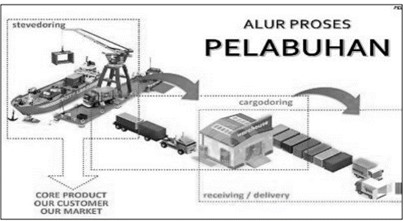RISK ANALYSIS OF WORK ACCIDENTS IN CONTAINER LOADING AND UNLOADING WORK WITH THE JOB SAFETY ANALYSIS METHOD
DOI:
https://doi.org/10.62012/sensistek.v6i2.31693Keywords:
Kata kunci, Bongkar Muat, Bahaya, Job Safety Analysis, Pengendalian, ResikoAbstract
An activity at a container port is not without risk, usually operating lifting and transportation support equipment in the form of rubber tyre gantry crane (RTG) or loading container crane (CC). In loading and unloading is one of the big causes of work accidents. One way to control potential risks and hazards is first by analyzing the possibility of work accidents using Job Safety Analysis (JSA) to minimize the possibility of work accidents during the loading and unloading process. This study aims to analyze the potential hazards and risks arising in each container handling activity, using JSA analysis and identifying actions or procedures to control potential hazards and risks that will arise at each stage of work. The advantage of this research is that it can be used as a basis and information in the form of hazards and risks of work accidents and to conduct occupational safety analysis such as assessment of the risk of work accidents in this field. The process of loading and unloading containers is a reference in controlling the risk of accidents in the workplace, especially during handling or haulage activities. The analysis process is carried out after, the process of identifying potential hazards is carried out. Risk assessment is a process of prioritizing the control of the risk level of accidents or occupational diseases, so as to reduce the increased risk of accidents in the loading and unloading processDownloads
References
Y. Suleman, "Analisis Risiko Kecelakaan Kerja pada Proses Bongkar Muat Peti Kemas Makassar New Port Dengan Metode Job Safety Analysis (JSA)," Skiripsi, pp. 1-7, 2019.
R. Setyarso, "Kesehatan Dan Keselamatan Kerja," Selasa 05 2020.
D. M. Putri, "Penilaian Risiko Keselamatan Kerja Pada Proses Pembuatan Balok Jembatan Dengan Metode Job Safety Analysis (JSA)"," vol. 6, pp. 1-2, 2017.
I. Pratama, E. Murdiyanto and A. M. Purwantomo, "Penanganan Pelaksanaan Bpngkar Muat VCM (C2H3CL) Di Kapal MT. Gas Kalimantan LPG Carrier Type-C"," Dinamika Bahari, vol. 9, 2018.
M. Handajani, "Analisis Kinerja Operasional Bongkar Muat Peti Kemas Pelabuhan Tanjung Emas Semarang," Teknik Sipil, Universitas Semarang, 2019.
T. A. Arungpadang and A. H. Hipan, "Simulasi Proses Bongkar Muat peti Kemas," Jurnal Tecno Mesin, vol. 2, pp. 46-47, 2015.
R. Ridwan and M. A. L. Pambudi, “Singapore International Hub-Port And Its Effects On The Smooth Running Of The Sea Freight Transportation System In Indonesia”, Journal of Maritime Technology and Society, vol. 2, no. 3, pp. 125-134, Oct. 2023.
A. Ashury and J. Indah Pricilla, “Analysis of Container Loading and Unloading Times on Ship To Shore (STS) Cranes at Teluk Lamong Port”, zonalaut, vol. 1, no. 3, pp. 92-98, Nov. 2020.
G. W. Utama, M. Basuki and P. I. Santosa, "Analisis Risiko Kesehatan Dan Keselamatan Kerja (K3) Bongkar Muat Di Pelabuhan Mayang," Semintan, pp. 112-113, 2019.
O. Nwaogbe, S. Bissalla, V. Omoke, J. U. Eru, and H. Y. Wokili, “Analysis Of Seaport Safety In Nigeria: Case Of Apapa Port Complex Lagos”, Journal of Maritime Technology and Society, vol. 2, no. 3, pp. 102-112, Oct. 2023.













